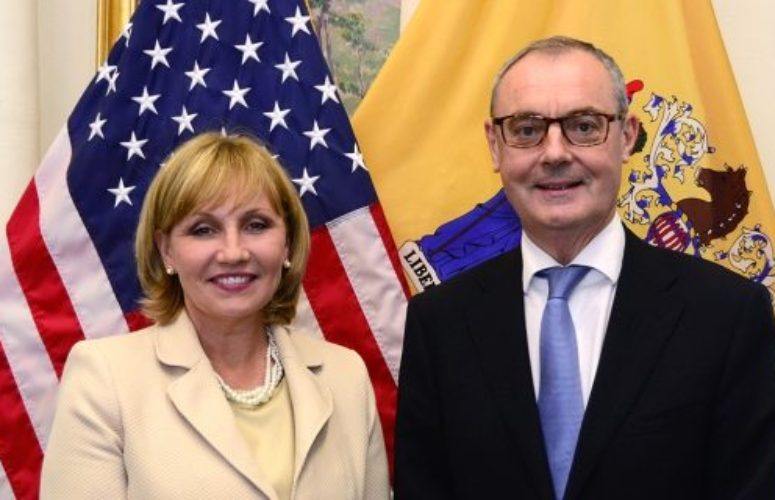
Foreign Trade Missions
Going abroad to find buyers is not as foreign an idea as you think it is.
By Anthony Birritteri, Editor-in-Chief On Dec 7, 2015While business owners who have never attended overseas foreign trade missions may envision themselves jet-setting to distant lands to sightsee and hobnob with ambassadors, prime ministers, royal families and the like, the truth is that these events are usually jam-packed with business meetings from the early morning until late in the evening. In short, they are hard work.
“They are exhausting,” comments Susan Widmer, director of the Northern NJ Export Assistance Center in Newark, one of 100 US- and 70 foreign-based centers operated by US Department of Commerce with the mission of helping small- to mid-sized companies sell their products and services overseas and, as a result, create jobs here on US soil. The name for the US Commerce Department’s office that arranges, sponsors and certifies these trade missions is Commercial Service (formally referred to as the US and Foreign Commercial Service). Widmer has been with this department for 22 years, the last five of which have been in northern New Jersey (the office that handles central and southern New Jersey is based in Lawrenceville).
In 2014 and 2015, Widmer led trade missions to India and China for US-based franchise operators. She says of the rigorous missions, “You don’t just sightsee. Our folks schedule back-to-back meetings with potential partners, there are networking sessions and market and political briefings with the local consulates and embassy officials. But then there are receptions and luncheons. … it’s fruitful, but it’s a go-go kind-of-thing,” she says.
“We design missions to be 8-am-to-9-pm days, adds Frank Spector, acting director for trade missions for Commercial Service in Washington, DC. “Missions, on average, last a full week, so we try to pack the schedule with as many business meetings as we can give attendees. The overall goal is to connect American sellers with international buyers in a short period of time, which will hopefully – over the long term – lead to international sales.”
The importance of attending a foreign trade mission and entering the waters of international trade is best explained by Herb Ouida, director of the Global Enterprise Network at Fairleigh Dickinson University, who says that any successful businesses needs to have 20 to 30 percent of sales in international markets for diversification reasons. “What happens if there is a market shift [in the US]?” he says. “You can’t put all of your [marketing] eggs in one basket.”
More importantly, looking at the international trade imbalance the US and NJ continuously experience, Ouida states, “Foreign companies continue to import to the US … they are already competing with you. And you are not going to their markets to compete with them?
“It’s a global economy,” he continues. “Everyone complains about NAFTA and the pending Trans-Pacific Partnership Trade Accord, but you have to realize; there are no more borders.”
So how does a company participate in a foreign trade mission? For starters, one can visit www.export.gov to see what missions Commercial Service is leading and discover all the rules, regulations, forms and fees associated with these missions. Trade missions can specifically be led by Commercial Service, or the office can certify missions held by chambers of commerce, business organizations, industry trade associations, state and local governments and export-oriented groups, to name a few, all of which work with Commercial Service and its offices abroad.
Commercial Service’s own trade missions can be vertical in nature, such as the franchise trade mission mentioned earlier, or horizontal, such as its annual Trade Winds mission, which was held in Africa this past September. During this year’s mission, more than 100 US companies learned about opportunities in Sub-Saharan African markets: Angola, Ethiopia, Ghana, Kenya, Mozambique, Nigeria, South Africa and Tanzania.
Spector’s office handles Commercial Service’s vertical trade missions. “Generally, this means no more than three industry sectors. This way, we can focus an embassy’s attention solely on these sectors and spend time planning and making the appropriate matches for business-to-business meetings,” he says. This past October, such a vertical trade mission was held for US architects and engineers who visited the United Arab Emirates. This coming February, an information technology mission will go to India, while an aerospace mission will go to Singapore.
The deadline to apply for a Commercial Service trade mission is usually 10 weeks prior to an event. Spector explains the reason for this is that it takes time to vet US companies so that “the most appropriate attend the trade mission.” On the other side of the coin, overseas Commercial Service offices vet the foreign companies that participate. “That’s why this takes so long. We conduct research on what companies would be good matches. We don’t want a foreign company meeting with an American company with no likelihood that any business will take place,” he says.
It is important to note that all businesses attending a Commercial Service trade mission (and most other trade missions for that matter) must pay their own way. In New Jersey, the cost of participating can be reduced, at least to some degree, by a New Jersey State Trade and Export Promotion (NJ STEP) grant. The grant, approximately $498,000 for the program’s third year of operation (running from September 2015 – September 2016), is administered by the New Jersey Business Action Center’s (BAC) Office of International Business Development and Protocol, and federally funded by the US Small Business Administration. Awarded money can be used to participate in select trade and business development missions led by the US government, or to take part in Commercial Service offering such as business matchmaking, partner searches, personalized business matchmaking and attending trade shows that offer meetings through Commercial Service’s International Buyers Program to meet with pre-screened buyers and receive export counseling at these events. Applications, certificates and other information regarding STEP can be found at www.NJ.STEP.gov.
Carol McPhillips, deputy executive director of the BAC, explains that the center works closely with Commercial Service and helps companies in New Jersey register for its trade missions, and that STEP money can be used to reimburse any related registration fees.
Lauren Moore, BAC executive director, is excited about the STEP program’s success, which started as a $203,000 grant during the state’s first year of funding (over 42 companies assisted), to $275,000 its second year (54 companies assisted), to $498,000 this year – an 81 percent increase.
With the first-year funding of $203,000, participating companies recorded more than $3.57 million of actual export sales, which were achieved by traveling to five continents and meeting with prospective customers in 30 countries, including Australia, Cameroon, France, Saudi Arabia, Taiwan and the United Kingdom.
In total, New Jersey companies exported $36.6 billion worth of products and services last year. The top 10 countries the state exports to are: Canada, Mexico, United Kingdom, Netherlands, Japan, South Korea, China, Hong Kong, Germany and France. In 2013, exports sustained 20,711 New Jersey companies, of which 92.1 percent were small- and medium-sized enterprises with fewer than 500 employees.
Conversely, the state holds trade missions to foreign countries to attract foreign direct investment to New Jersey. Choose New Jersey, part of the New Jersey Partnership for Action, as is BAC, handles these “lead development trade missions,” as Moore calls them.
According to Choose New Jersey President and Chief Executive Officer Michele Brown, Choose organizes trade missions for the governor’s office and Choose New Jersey board members “to talk about our state as a great place for a foreign company to set up and grow a business.”
To date, Choose New Jersey trade missions, which have included Governor Christie or Lt. Governor Kim Guadagno, as well as Choose New Jersey Board members and higher education leaders, have been to Israel (in 2012), Mexico and Canada (2014) and the United Kingdom (2015).
Working with the US Commerce Department and various overseas organizations to set up meetings with foreign leaders and business owners, Brown says that deals, based on initial trade mission visits, take time to close and come to fruition. A case in point is the first trade mission to Israel in 2012, when state representatives met with leaders from SodaStream International, the world’s largest manufacturer, distributor and marketer of home carbonation systems. “During that mission, company executives said they were considering an expansion in the US. SodaStream USA already had operations in Pennsauken, but it was considering an expansion in Utah. It wasn’t until last year that the company finally made the decision to stay in New Jersey, thanks to a New Jersey Economic Development Authority Grow NJ grant, which helped retain 31 jobs, create 26 new ones and allow the company to invest more than $1 million in its Pennsauken facility,” Brown says. She is now waiting to hear word concerning another Israeli company’s commitment to New Jersey, which stemmed from the 2012 trade mission.
Discussions are ongoing with at least five Canadian companies, stemming from that trade mission in 2014. The trip to the United Kingdom resulted in a Memorandum of Understanding between OneNucleus in Cambridge, one of Europe’s largest life sciences organizations, and BioNJ, which Brown hopes will help build relationships and R&D opportunities between the UK and New Jersey.
Asked what area of the globe Choose New Jersey is targeting for its next trade mission, Brown says it may be Europe. “We analyzed the industries that are experiencing job growth in New Jersey, and we found that the healthcare and the biotech sectors are receiving a lot of interest from European companies. We may be attending Bio-Europe in the spring (Stockholm, Sweden from April 4-6). As we look at advance manufacturing, logistics and distribution, we may attend a show in Germany in the spring, as well,” she says.
New global opportunities are presenting themselves to New Jersey companies as Congress reviews the pending Trans-Pacific Partnership Trade Accord, which will set new terms for trade and business investment between the US and 11 Pacific Rim nations (Australia, Brunei Darussalam, Canada, Chile, Japan, Malaysia, Mexico, New Zealand, Peru, Singapore and Vietnam). US goods exports to TPP countries totaled $698 billion in 2013, representing 44 percent of total US goods exports. Another trade agreement undergoing talks is the Transatlantic Trade and Investment Partnership (TTIP), which would further ease commercial trade between the US and the European Union.
Additionally, Cuba may be on the horizon as a new location where New Jersey companies can export and sell their products and services. The US and the communist nation established diplomatic relations – severed in 1961 – in July 2015. President Barack Obama is seeking to end the existing commercial, economic and financial embargoes, but this action requires Congressional approval.
Taking a trip to gauge potential opportunities in the country were members of the New Jersey Tech Council and its president and CEO, James Barrood. Visiting Cuba this past April (his second trip in 15 months), Barrood says, “We went to build relationships and better understand the business opportunities in Cuba. The country could be a great source of educated talent in the future, whether it’s for collaborations with industry or higher education. We want to make sure the smart techies, entrepreneurs and innovators in Cuba choose to transplant themselves to New Jersey rather than other parts of the US with large Cuban populations. We know this is a slow process, but you have to start somewhere, and you start by building relationships and understanding the culture and the economy.”
The opportunities are endless for New Jersey companies that want to conduct international trade, and attending a foreign trade mission can be an important step in gauging international opportunities. Widmer, at Commercial Service, says her office’s US-sponsored trade missions are more suitable for small- and mid-sized businesses, while larger corporations have their own experts and established relationships regarding international trade pursuits. However, she advises small business to take baby steps. “Signing up for a trade mission may not be the first thing a small business owner would want to do,” she says.
Spector adds, “The best thing to do is contact your closest US Export Assistance Center. There, an international trade specialist can work with your company to develop an international plan. I think it is important that all companies, particularly small ones, have some business counseling before they apply for and attend a trade mission.”
US and German Business Perspectives & Opportunities
East Coast Industry Forum covers the details impacting trans-Atlantic trade.

In his welcome address, Dietmar Rieg, president & CEO, German American Chambers of Commerce, Inc., said that this year, the US became Germany’s most important export market, surpassing France. According to the US Department of State, Germany exported goods worth more than $157 billion to the United States in 2014 and US exports to Germany totaled $77.8 billion.
Rieg said there are 148 German businesses in New Jersey, with 98 of those companies having their US-based headquarters here. These companies employ more than 25,000 people in the state.
New Jersey Business & Industry Association Vice President Frank Robinson moderated a panel on the future of manufacturing. He explained the different phases of the industrial revolution, starting with hydro power, to electric, to digital, to today’s fourth revolution that the Germans call Industry 4.0, but in the US is synonymous with “smart factories.” Either term represents “the embracing of automation, data exchange and manufacturing technology,” Robinson explained.
Andrew Campbell, president of Jersey City-based Eastern Millwork, Inc. (EMI), discussed how he implemented processes to automate labor intensive work at his company. Visiting and learning from German firms, even recruiting German engineers for EMI, Campbell says the company’s job today is more about managing information than managing materials.
In her keynote remarks, Lt. Governor Kim Guadagno discussed the state’s positive attributes and why more German businesses should expand in New Jersey. She explained to the audience how the state helped Bayer HealthCare, parent of German-based Bayer, establish new US headquarters on a 94-acre campus in Whippany – a $250-million investment consolidating Bayer’s existing New York and New Jersey operations. Some 2,400 employees are now based at the new location.
“I will sit down with you and bring to the table every single agency you need to help you make an objective decision and make you feel welcome,” Guadagno told the German business leaders in the audience, enticing them to choose New Jersey.
Related Articles:





